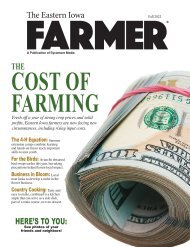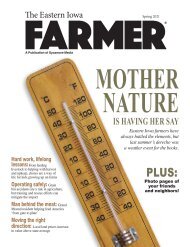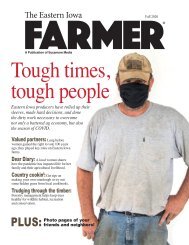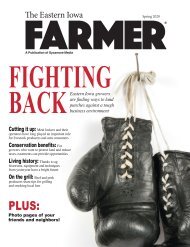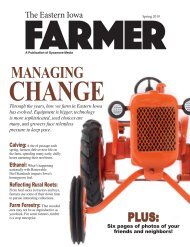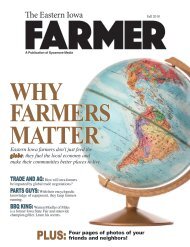Create successful ePaper yourself
Turn your PDF publications into a flip-book with our unique Google optimized e-Paper software.
Ag Bytes<br />
where she specializes in executive-level<br />
searches for the agribusiness industry.<br />
Also speaking is Kiley Fleming, the executive<br />
director of Iowa Mediation Services,<br />
who released her book “Conflict Imagery”<br />
earlier this year.<br />
Other topics to be addressed include<br />
farmland management, making the most<br />
of your leadership style, entrepreneurship,<br />
personal finance and lifestyle balance. A<br />
panel of current Iowa agricultural board<br />
leaders will share insights on leading and<br />
being influences in agriculture. Some of<br />
the tour highlights include the new Veterinary<br />
Medicine Diagnostics Laboratory and<br />
campus greenhouses.<br />
Also on tap is the celebration of the<br />
20th anniversary of Annie’s Project, from<br />
which the conference developed.<br />
More land leased; less than<br />
half of farmland owners farm<br />
As the average age of Iowa’s farmland<br />
owners continues to rise, other trends in<br />
landownership have begun to emerge.<br />
According to an Iowa State University<br />
study, 58% of Iowa’s farmland is now<br />
leased out, a significant increase from the<br />
last time the same study was conducted<br />
in 2017.<br />
“There is a long-term trend toward farmland<br />
leasing since 1982,” said Wendong<br />
Zhang. Zhang is an assistant professor of<br />
economics at Cornell University and conducted<br />
the Iowa Farmland Ownership and<br />
Tenure Survey with Jingyi Tong, a PhD<br />
student in economics at Iowa State.<br />
“The percentage of farmland being<br />
leased in Iowa increased from 53% in<br />
2017 to 58% in 2022. This represents a<br />
relative increase of roughly one million<br />
acres over five years, which is quite significant,”<br />
Zhang said.<br />
Conducted by Iowa State since the<br />
1940s, the Iowa Farmland Ownership and<br />
Tenure Survey – completed every five<br />
years – focuses on forms of ownership,<br />
tenancy and transfer of farmland in Iowa,<br />
and characteristics of landowners.<br />
The latest survey was conducted in July<br />
2022, and was funded by Iowa State’s<br />
College of Agriculture and Life Sciences,<br />
Iowa Nutrient Research Center, Leopold<br />
Center for Sustainable Agriculture, Department<br />
of Economics, Center for Agricultural<br />
and Rural Development and Iowa<br />
State University Extension and Outreach.<br />
Farmland leases also increasingly favor<br />
cash rent over crop sharing and owner-operating<br />
arrangements. In 2017, 82%<br />
Wendong Zhang,<br />
Assistant Professor<br />
of economics,<br />
Cornell University<br />
of leased farmland<br />
was cash rented,<br />
but cash rent,<br />
predominantly<br />
fixed-cash rental<br />
contracts, now<br />
account for 87% of<br />
leased land.<br />
“The rise of cash<br />
rent, especially<br />
fixed cash rent,<br />
correlates with the<br />
growing percentage<br />
of landowners<br />
who are part-time<br />
and non-residents<br />
of Iowa,” Zhang<br />
said. “Fifty-five<br />
percent of land is owned by an owner who<br />
did not farm in 2022, and, of them, over<br />
half do not have farming experience. Especially<br />
for those landowners, a fixed cash<br />
rental contract is a natural choice.”<br />
According to the study, 47% of farmland<br />
was directly operated by the landowner in<br />
2017, but that number has now fallen to<br />
just 42%.<br />
The survey found that the average age<br />
of Iowa’s farmland owners is still increasing.<br />
In 1982, only 29% of Iowa farmland<br />
was owned by those over the age of 65.<br />
That percentage has steadily increased<br />
over the years, totaling 60% in 2017 and<br />
66% today. Tong noted that women own<br />
46% of Iowa’s farmland, and they hold a<br />
larger share among senior owners.<br />
Tong said several factors are contributing<br />
to the increasing age of Iowa’s<br />
farmland owners, including the increase<br />
in using farmland as an inheritance or<br />
long-term investment, fewer young people<br />
going into farming, and those young farmers<br />
facing large start-up costs.<br />
“Also, some senior farmers may retain<br />
ownership of their land due to a lack of<br />
succession planning, thus keeping the<br />
farm even if they aren’t actively farming.<br />
The survey shows 17% of landowners<br />
neither have a successor for ownership or<br />
management,” Tong said.<br />
However, Tong noted that survey results<br />
show three of every four landowners<br />
in Iowa are interested in selling land to<br />
beginning farmers when incentivized with<br />
federal and state tax credits.<br />
“At the same time, over half of Iowa<br />
landowners expressed concerns about<br />
difficulty finding quality beginning farmers<br />
as well as beginning farmers’ ability to pay<br />
the best prices for land,” Tong said.<br />
The recent survey also reveals changing<br />
trends in how ownership of Iowa’s<br />
farmland is held. In<br />
1982, 80% of Iowa’s<br />
farmland was<br />
owned through<br />
a combination of<br />
sole ownership<br />
and joint tenancy;<br />
however, those<br />
now only account<br />
for 52% of Iowa<br />
farmland ownership.<br />
Meanwhile,<br />
the amount of<br />
farmland held in<br />
Jingyi Tong, trusts has skyrocketed<br />
from 1%<br />
PhD economic student<br />
at Iowa State University in 1982 to 23%<br />
today.<br />
“Trusts have grown in popularity due to<br />
their numerous benefits. Particularly for<br />
farmland owners, trusts can ensure the<br />
preservation of the farm within the family,<br />
manage land transitions, and potentially<br />
provide tax benefits, making them a valuable<br />
tool in succession planning,” Zhang<br />
said.<br />
The percentage of farmland owned<br />
debt-free has also continued to increase –<br />
84% of Iowa farmland is held without any<br />
debt, the highest level observed. This represents<br />
a steady and significant increase<br />
from 1982, a year that marked the onset<br />
of the farm debt crisis, when only 62% of<br />
the land was held without debt. Tong said<br />
that some of that recent increase is due<br />
to the hike in commodity profits, aging<br />
landowners coupled with longer lengths<br />
of ownership, and government payments<br />
during the COVID-19 pandemic.<br />
Zhang said that the survey also found<br />
interesting trends in the use of conservation<br />
techniques on Iowa farmland. He<br />
noted that no-till farming saw a significant<br />
increase from 21% of owners and 27% of<br />
acres in 2017 to 29% and 30%, respectively,<br />
in 2022.<br />
“The use of cover crops also saw a<br />
slight increase over this period, from 5%<br />
of owners and 4% of acres in 2017 to 7%<br />
for both owners and acres in 2022,” he<br />
said.<br />
However, only 2% of Iowa landowners<br />
have already participated in a carbon<br />
credit program and another 3% are considering<br />
doing so, but, Zhang said, “most<br />
landowners are either not interested or<br />
have never heard of them.”<br />
More information about the 2022 Iowa<br />
Farmland Ownership and Tenure Survey<br />
results can be found on the CARD website<br />
at card.iastate.edu/.<br />
84 EASTERN IOWA FARMER | FALL 2023 eifarmer.com<br />
<strong>Eastern</strong>Iowa<strong>Farmer</strong>_South_Fall2023.indd 84<br />
9/19/23 3:35 PM







